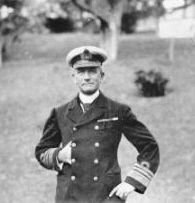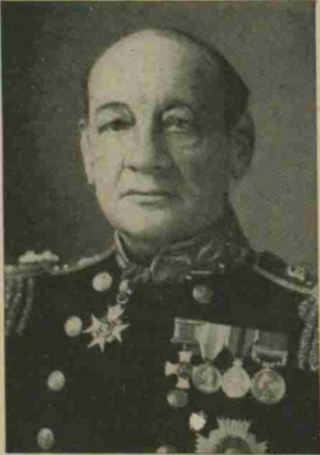
The Second Sea Lord and Deputy Chief of Naval Staff is deputy to the First Sea Lord and the second highest-ranking officer to currently serve in the Royal Navy and is responsible for personnel and naval shore establishments. Originally titled Second Naval Lord in 1830, the post was restyled Second Sea Lord in 1904. They are based at Navy Command, Headquarters.

The Home Fleet was a fleet of the Royal Navy that operated from the United Kingdom's territorial waters from 1902 with intervals until 1967. In 1967, it was merged with the Mediterranean Fleet creating the new Western Fleet.

Admiral of the Fleet Sir George Astley Callaghan was an officer in the Royal Navy. During the Boxer Rebellion he served as commander of a naval brigade sent ashore to form an element of a larger expedition under Lieutenant-General Sir Alfred Gaselee: the expedition entered Peking and rescued the legations which had been held hostage there. He came to prominence again when, as Second-in-Command of the Mediterranean Fleet, he assisted with the provision of aid to survivors of the Messina earthquake, which had caused the loss of circa 123,000 lives.

The Atlantic Fleet was a naval fleet of the Royal Navy. It existed for two separate periods; 1909 until 1914, and then 1919 until 1932.

The Commander-in-Chief, The Nore, was an operational commander of the Royal Navy. His subordinate units, establishments, and staff were sometimes informally known as the Nore Station or Nore Command. The Nore is a sandbank at the mouth of the Thames Estuary and River Medway.

The Channel Fleet and originally known as the Channel Squadron was the Royal Navy formation of warships that defended the waters of the English Channel from 1854 to 1909 and 1914 to 1915.

Sasebo Naval District was the third of five main administrative districts of the pre-war Imperial Japanese Navy. Its territory included the western and southern coastline of Kyūshū, the Ryukyu Islands, Taiwan and Korea, as well as patrols in the East China Sea and the Pacific

Admiral Sir George Edwin Patey, was a senior officer in the Royal Navy.
Rear Admiral Hugh Richard Marrack was a submarine specialist serving in the British Royal Navy, who commanded both the Portland and China Submarine flotillas and was Commodore Superintendent, Gibraltar, 1943–45. Marrack later became an ADC to King George VI.

Admiral of the Fleet Sir Arthur Dalrymple Fanshawe, was a Royal Navy officer. As a captain he became commanding officer, successively, of the troopships HMS Jumna and HMS Malabar, which were tasked with ferrying troops between the United Kingdom and India. These were difficult commands with regular disputes between the military officers in charge of the troops and the naval officers in command of the ships.

Admiral Sir John Durnford was a Royal Navy officer who went on to be Commander-in-Chief, Cape of Good Hope Station.

The Royal Naval College, Greenwich, was a Royal Navy training establishment between 1873 and 1998, providing courses for naval officers. It was the home of the Royal Navy's staff college, which provided advanced training for officers. The equivalent in the British Army was the Staff College, Camberley, and the equivalent in the Royal Air Force was the RAF Staff College, Bracknell.

The Naval Intelligence Department (NID) was the intelligence arm of the British Admiralty from 1887 until 1912 when most of its subsidiary divisions were absorbed during the creation of the Admiralty War Staff department that included a new Naval Intelligence Division that concentrated in that sphere solely. It dealt with intelligence matters concerning British naval plans, and with the collection of naval intelligence in regard to coastal defences, foreign powers, mobilisation, trade and war.

The Naval Mobilisation Department also known as the Mobilisation and Movements Department was a former department of the British Admiralty initially from 1909 to 1912 and then again from 1918 to 1932. It was mainly responsible for plans, mobilisation and manning during the pre-World War I and post war period.

The Naval Ordnance Department, also known as the Department of the Director of Naval Ordnance, was a former department of the Admiralty responsible for the procurement of naval ordnance of the Royal Navy. The department was managed by a Director, supported by various assistants and deputies; it existed from 1891 to 1958.

The Admiral Commanding, Reserves, was a senior Royal Navy post that existed from 1875 to 1976.

The 2nd Cruiser Squadron was a formation of cruisers of the British Royal Navy from 1904 to 1919 and from 1921 to 1941 and again from 1946 to 1952.
The 1st Destroyer Flotilla, also styled as the First Destroyer Flotilla, was a naval formation of the British Royal Navy from 1909 to 1940 and again from 1947 to 1951.

The Chief of Staff, Mediterranean Fleet also formally known as Chief of Staff to the Commander-in-Chief Mediterranean Fleet and originally called Flag Captain, Mediterranean Fleet. was a senior British Royal Navy appointment. He was the commander-in-chiefs primary aide-de-camp providing administrative support from October 1893 to 1967.









